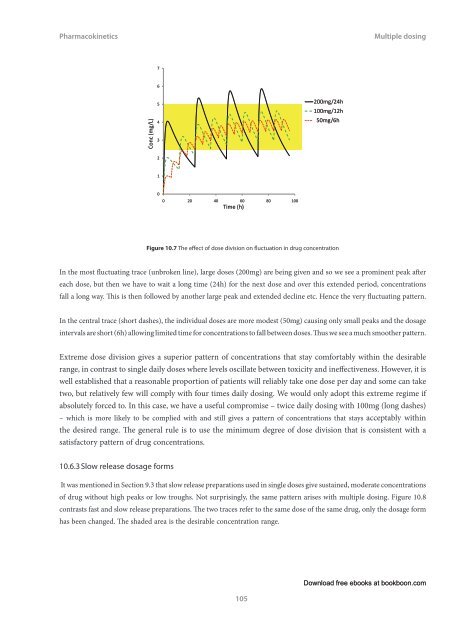Pharmacokinetics Language English Format: PDF Price - Tutorsindia
Pharmacokinetics Language English Format: PDF Price - Tutorsindia
Pharmacokinetics Language English Format: PDF Price - Tutorsindia
- No tags were found...
Create successful ePaper yourself
Turn your PDF publications into a flip-book with our unique Google optimized e-Paper software.
<strong>Pharmacokinetics</strong>Multiple dosing76Conc (mg/L)543200mg/24h100mg/12h50mg/6h2100 20 40 60 80 100Time (h)Figure 10.7 The effect of dose division on fluctuation in drug concentrationIn the most fluctuating trace (unbroken line), large doses (200mg) are being given and so we see a prominent peak aftereach dose, but then we have to wait a long time (24h) for the next dose and over this extended period, concentrationsfall a long way. This is then followed by another large peak and extended decline etc. Hence the very fluctuating pattern.In the central trace (short dashes), the individual doses are more modest (50mg) causing only small peaks and the dosageintervals are short (6h) allowing limited time for concentrations to fall between doses. Thus we see a much smoother pattern.Extreme dose division gives a superior pattern of concentrations that stay comfortably within the desirablerange, in contrast to single daily doses where levels oscillate between toxicity and ineffectiveness. However, it iswell established that a reasonable proportion of patients will reliably take one dose per day and some can taketwo, but relatively few will comply with four times daily dosing. We would only adopt this extreme regime ifabsolutely forced to. In this case, we have a useful compromise – twice daily dosing with 100mg (long dashes)– which is more likely to be complied with and still gives a pattern of concentrations that stays acceptably withinthe desired range. The general rule is to use the minimum degree of dose division that is consistent with asatisfactory pattern of drug concentrations.10.6.3 Slow release dosage formsIt was mentioned in Section 9.3 that slow release preparations used in single doses give sustained, moderate concentrationsof drug without high peaks or low troughs. Not surprisingly, the same pattern arises with multiple dosing. Figure 10.8contrasts fast and slow release preparations. The two traces refer to the same dose of the same drug, only the dosage formhas been changed. The shaded area is the desirable concentration range.105Download free ebooks at bookboon.com
















